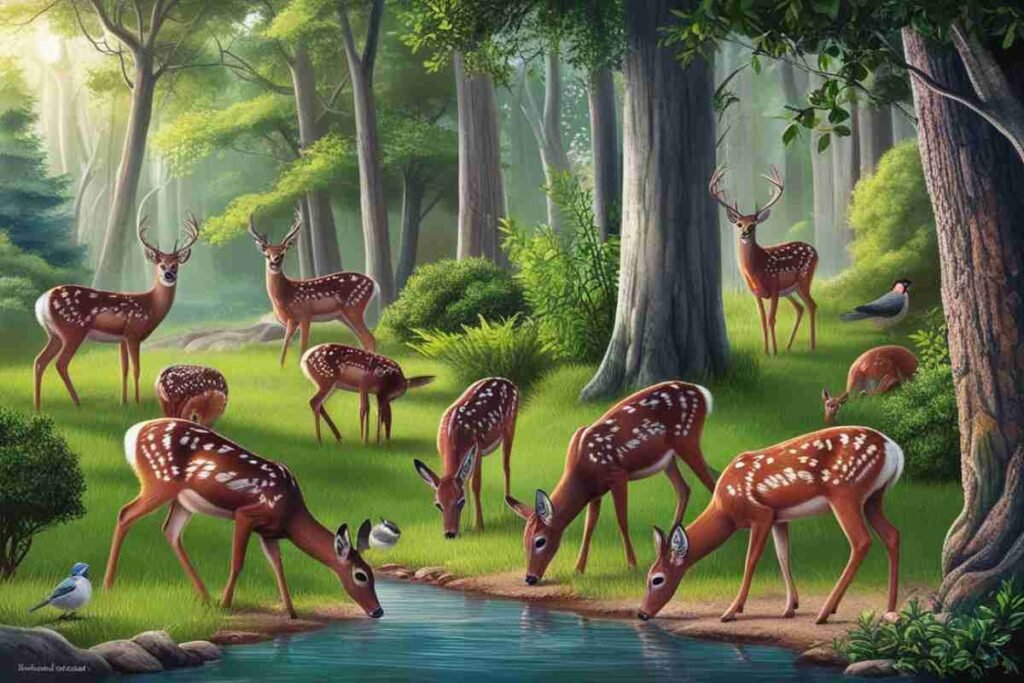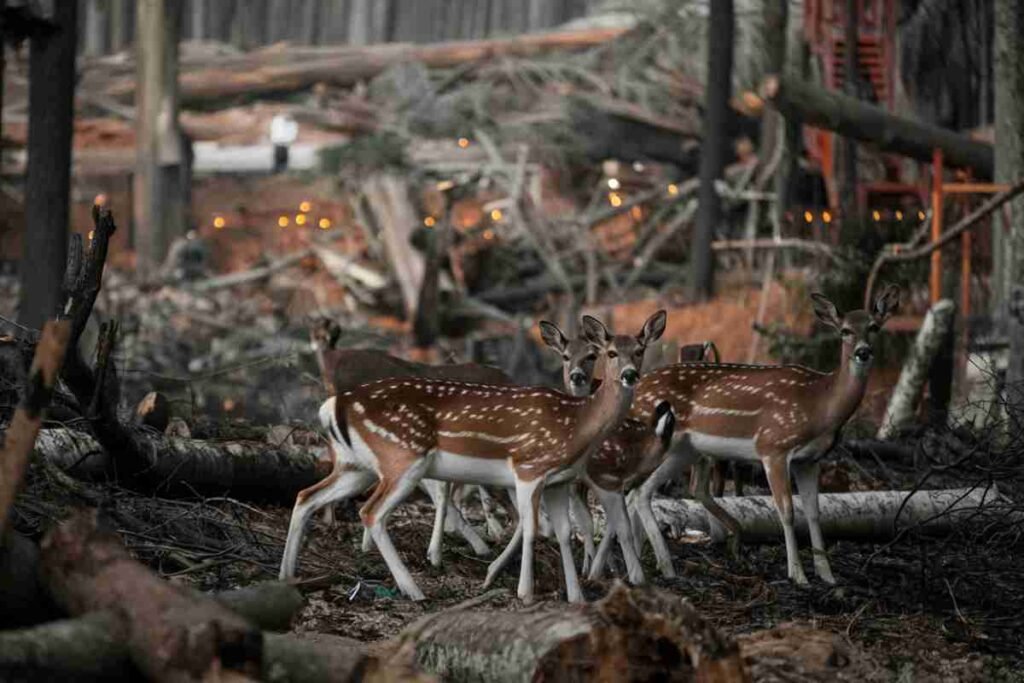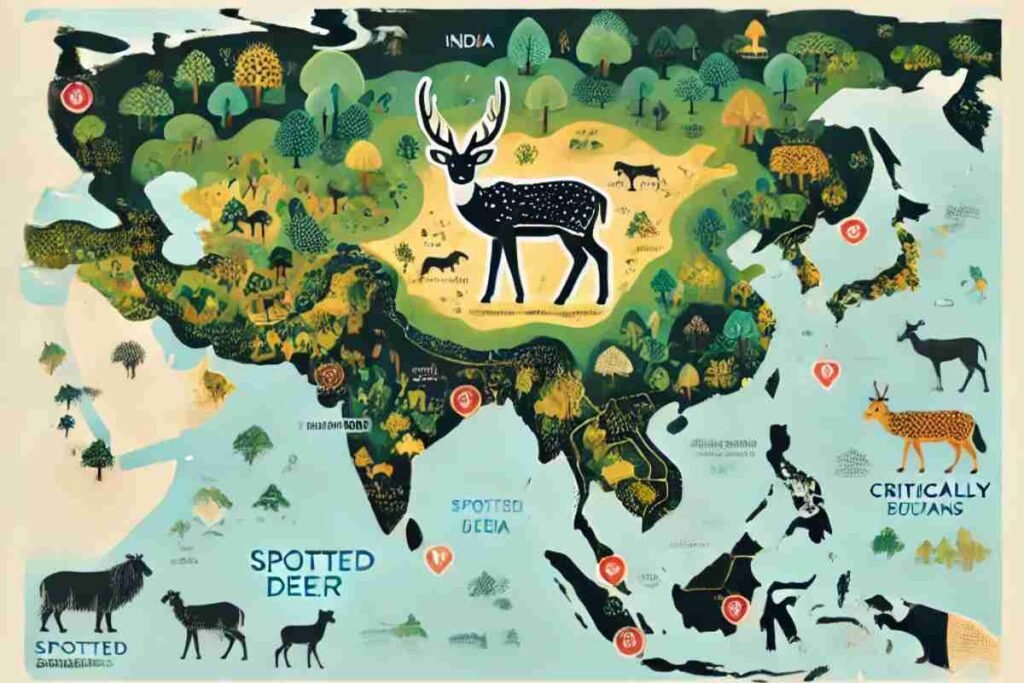The Spotted Deer also known as the Chital or Axis deer is a beautiful herbivore native to the Indian subcontinent’s forests and grasslands.
Its distinctive white spotted coat, elegant antlers and calm behavior make it one of the most admired species in the wild.
From unique social habits to fascinating survival instincts explore 7 incredible facts that will truly captivate your curiosity and draw you into the world of this gentle deer.
Habitat of the Spotted Deer

The spotted deer is most commonly found in the tropical and subtropical regions of Asia, thriving in environments that offer a balance of abundant vegetation, water sources, and shelter.
These deer are highly adaptable and can survive in a variety of habitats, but they particularly favor areas that provide ample food and safety from predators.
Their ability to live in dense forests and open grasslands allows them to maintain a stable population across various regions, though they are increasingly facing challenges due to habitat loss and human activities.
Where You’ll Find them
- India and Sri Lanka: Home to the largest populations, these countries offer the ideal habitat for them. National parks and wildlife sanctuaries like Kanha and Bandhavgarh in India provide protected environments where these deer can thrive in the wild.
- Southeast Asia: In countries like Nepal, Bhutan, and parts of Myanmar, they are commonly found in forested areas and along riverbanks, where they benefit from rich vegetation and access to fresh water.
- Other Introduced Regions: They have also been introduced to other parts of the world, such as Australia and the United States, where small populations have been established in wildlife parks and reserves. .
Key Habitat Features
- Dense Forests for Protection from Predators: They are often found in dense forests, which offer crucial cover from predators like tigers, leopards, and wild dogs. The dense canopy of trees provides them with the ability to hide, making it easier to escape threats.
- Open Grasslands for Grazing: While they prefer the cover of forests, they also thrive in open grasslands where they can easily find food. These grasslands provide a rich variety of grasses, shrubs, and fruits that support their herbivorous diet.
- Water Bodies like Rivers and Lakes for Hydration: They are typically found near water sources such as rivers, lakes, and ponds. These areas not only offer a consistent water supply for hydration but also attract various plant species, making it an ideal place for deer to graze and forage for food.
The Role of Spotted Deer in the Ecosystem
They contribute significantly to the balance of nature. By grazing on plants, they help maintain healthy grasslands, which benefits other animals in the habitat. Additionally, they serve as prey for large predators like tigers and leopards, sustaining the food chain.
Why Are They Important?
- Seed Dispersal: Their diet helps in spreading seeds, promoting forest regeneration.
- Grassland Management: They prevent overgrowth by feeding on shrubs and grasses.
- Supporting Predators: Predatory species rely on them as a food source.
Cultural Significance of the Spotted Deer
The spotted deer has been a symbol of beauty and grace for centuries. In Hindu mythology, they are sacred animals often associated with gods like Krishna.
They are also depicted in art and literature, symbolizing purity and harmony. In rural areas, locals often regard them as peaceful creatures, embodying the serenity of nature.
Threats Facing Spotted Deer

Despite their adaptability, they face growing threats due to human activities. Their habitats are being destroyed, and illegal hunting continues to affect their populations.
Top Threats
- Habitat Loss: Deforestation for agriculture and urban development reduces their living spaces.
- Poaching: Hunted for their meat and hides.
- Competition with Livestock: Domestic animals often overgraze, leaving limited food for wildlife.
- Human-Wildlife Conflict: As they venture into human settlements, they are at risk of harm.
Conservation Efforts for Spotted Deer
Efforts to conserve they have been increasing in recent years. Governments and wildlife organizations are setting up sanctuaries and enforcing laws to protect these animals from poaching.
How Are They Being Protected?
- Wildlife Sanctuaries: National parks like Kanha and Bandhavgarh in India provide safe havens.
- Laws Against Poaching: Strong penalties deter illegal hunting.
- Eco-Tourism: Funds generated from tourism support conservation programs.
How You Can Help?
- Donate to wildlife organizations.
- Promote awareness about spotted deer conservation.
- Avoid buying products made from animal hides.
Fun Facts About Spotted Deer
- Excellent Swimmers: They can cross rivers with ease.
- Social Animals: They live in herds of 10–50 members, led by a dominant male.
- Lifespan: In the wild, they live up to 8–14 years.
- No Fixed Breeding Season: They can mate throughout the year, depending on the availability of food.
Geographic Distribution and Population Status

The spotted deer is native to India and neighboring regions but has also been introduced to other countries for conservation and tourism purposes.
Current Population Trends
- Stable in protected areas like national parks.
- Declining in unprotected regions due to habitat loss and poaching.
Interesting Fact
In some places where they’ve been introduced, they have adapted surprisingly well to new climates.
Conclusion
The spotted deer, with its serene beauty and ecological importance, symbolizes the delicate balance of nature and the urgent need for its preservation amidst modern environmental challenges.
Despite being resilient and adaptable, this gentle species continues to face escalating threats from deforestation, poaching and human encroachment that jeopardize its survival.
Protecting the spotted deer means safeguarding biodiversity, supporting predator prey dynamics and preserving a vital cultural icon of harmony and natural grace.
FAQs
What is a spotted deer?
The spotted deer also known as chital or Axis deer is a medium sized herbivore with a reddish brown coat and white spots. It is native to the Indian subcontinent.
Where can spotted deer be found?
They are mainly found in India, Sri Lanka, Nepal, and parts of Southeast Asia. Small introduced populations also exist in countries like Australia and the USA.
What do spotted deer eat?
Spotted deer are herbivores that feed on grasses, leaves, fruits, and shrubs. They often graze in grasslands and forest edges.
Why are spotted deer important to the ecosystem?
They help maintain plant balance by grazing and serve as prey for large predators like tigers and leopards. They also aid in seed dispersal.
What are the main threats to spotted deer?
Habitat destruction, poaching, human-wildlife conflict, and competition with livestock are major threats to their survival.
How long do spotted deer live?
In the wild, spotted deer generally live between 8 to 14 years, depending on habitat conditions and threat
Are spotted deer endangered?
Spotted deer are not endangered overall, but their numbers are declining in areas without protection due to habitat loss and hunting.
How can people help conserve spotted deer?
You can help by donating to wildlife organizations, spreading awareness, and avoiding products made from animal hides.